Why Does My UV Light Not Make Urine Glow?
Occasionally customers have issues locating pet urine with their PeeDar or other blacklights. Here we’ll detail how to quickly check your light works, then we’ll provide a more in-depth look at all the major causes of reduced fluorescence, and finish with some key methods of identifying the source of a glow.
Before you go any further, first ensure your PeeDar’s light is a constant, strong light blue colour on standard white printer/writing paper.
All LEDs should be producing light of roughly the same intensity. If not, or you believe your unit is faulty in some other way, contact us and we can discuss issuing a free replacement!
Reduced/non-existent fluorescence is most likely to have come from some or all of the following:
- Insufficiently dried urine (the usual culprit!) – as it dries urine starts to increasingly, constantly, wick water moisture from its surroundings, whether it’s in a liquid form or moisture in the air. Humid air (e.g. from bathrooms, kitchens), wet absorbent materials, and regular pet urination (esp. larger animals) in/near the last urine patch can significantly reduce glows, in some cases to zero.
To see glows, secure the suspect area from animals/people/moisture-producing things so it has time to dry. In cases of potentially large amounts of urine, such as when it has seeped through many layers of carpet or deep into furniture you may literally need to dry the area for a few days, or up to a week at normal room temperature. Dry urine has a much more crystalline structure which is able to provide the greatest glows possible. If you can stomach the smell, faster drying may be achieved by novel methods of removing moisture, e.g. hair-drying or using a portable filament heater safely and carefully aimed at the edge of a wet stain.
Moisture meters are a good extra tool for locating wet (or dried – due to its wicking nature it is always at least a tiny bit wet!) urine. You can also ask your vet about “fluorescein”, it’s ingested by your pet, and peed out over a few days, fluoresces very brightly in wet or dry urine, and has the added advantage of being able to reveal individual problem pets and where they go. Remember too that neighbour’s pets can sometimes be the source of your urine woes. Cats have been known to visit other people’s homes to eat their pet cat’s food, amongst other possible antics. Dogs sometimes urinate in other people’s homes, such as when a dog owner invites a friend’s nervous/territorial/poorly trained dog round to play with their own dog.
- Low surface areas of dried urine – carpets have much larger surface areas for urine to dry on and then react with UV. Tiles, on the other hand, often emit less glows due to thinner layers of urine, and the ease with which urine can be cleaned/worn away.
- Majority of urine absorbed below the surface – common on furniture as well as other highly absorptive objects, urine can be absorbed deep below the surface with very little if any detected at the surface.
- Used/low power batteries – PeeDar LEDs use a lot of battery power. Used batteries can deliver markedly lower UV light output and therefore the resultant weaker glows can make finding urine stains difficult.
- Urine that naturally fluoresces very little – some pets are reported to have urine that naturally doesn’t fluoresce much if at all under UV, and usually not much can be done about this. Ingestion of large quantities of water is known to cause pets to pee out the chemicals in urine that create the yellow colour that seems to be responsible for fluorescence under UV.
One way to assess glow strength is by absorbing wet urine onto dry white tissue, shining your PeeDar on it once dry. Weaker glows will let you know searches should be slower and more methodical.
- Dark or patterned surfaces – darker colours absorb more light, reducing glows. During tests we’ve performed dark carpet colours such as deep blue and rich red did prove problematic, some glows were not detectable! Patterns make seeing edges of glows more difficult. Other types of glowing stains that cover suspect areas, such as those from cleaning fluids or some types of food, can also add to the confusion.
- Similarly glowing surfaces – although we’ve yet to see this, the sheer range of carpets on sale inevitably mean that some may glow with near enough the same intensity as your pet’s urine, this could make detecting contrasts, especially with weak glowing urine, quite difficult. Lighter coloured carpets, often of the same colour as dried urine, could create glows under UV.
Interestingly, at least from our experience, whitish coloured carpets (see our product’s before and after photos) are great for detecting dried urine. Lighter flooring colours naturally reflect more light away through the dried urine, this filters much of the visible light into the glow colours of the urine. Outlines are also more visible since the glowing surrounds are strongly a different glow colour to the urine. Such lighter carpets also have the added bonus of actually showing up some stains in normal daylight.
- Incorrectly tinted glasses – from tests we’ve performed, under 385nm any tint colours/shades in glasses, UV-protective or not, reduce the contrast of stains against their backgrounds, making stains harder to spot. We recommend using zero tinted 99% UV protective safety glasses when hunting for invisible urine stains with your PeeDar flashlights. If you’ve got a cheaper 390nm+ UV flashlight then we’d generally recommend yellow/amber coloured safety glasses, they tend to increase the contrast by cutting out the normally overpowering obscuring strong purple visible light.
- Not searching in complete darkness – although obvious, only by searching in pitch black conditions will you be giving yourself the best chance of seeing the full spectrum of glows at their brightest, from vivid and intense colours to the very faintest glows from older stains.
- Not searching in the right areas – sometimes you’ll smell the stains yet see nothing. This could well be because you simply have not looked around hard enough! Pets can appear to be very creative with where they urinate. Cats in particular can sometimes pee in the most seemingly unlikely places, such as on book shelves, behind doors and under tables or settees.
Lastly, finding the source of the glowing material can be difficult, UV lights simply highlight all fluoresce-able substances. We know that urine in general has a mid-to-low intensity glow compared with other fluorescing things, and is a light yellowy-white/straw colour. Cat urine can often have a faint light green tinge. Cat urine glows usually have spray or pool-shaped outlines, sprays are usually on more vertical surfaces, regular urination is typically on horizontal surfaces. Cat urine often has a very pungent ammonia smell too. Dog urine reportedly usually has less of an ammonia stench, older stains can sometimes not give off much smell, but generally all urine is usually unmistakable when sniffed close enough. Dog puke can appear as a dull/faint yellow/mustard colour. Cleaning fluids have among the strongest glows possible, often from their bleach component, and are usually a brilliant white or whitish purple/blue. Food glows are highly variable, from nothing to extremely vivid (e.g. Thai green curry glows a very strong straw/light greenish colour). Some juices such as orange juice show up as a deep red. This is a complex area as you are probably beginning to see.
When using your PeeDar with our advice and your natural senses, we’re sure you’ll be able to locate and eradicate all your pet’s mistakes with relative ease. Please do tell us how you get on!

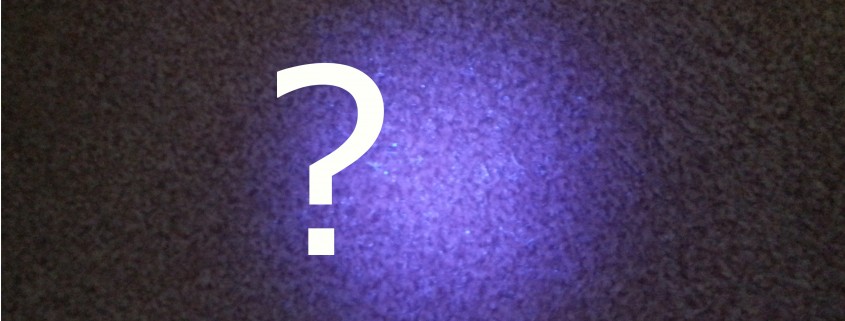
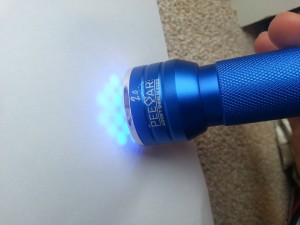
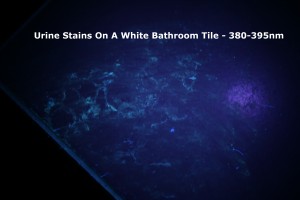
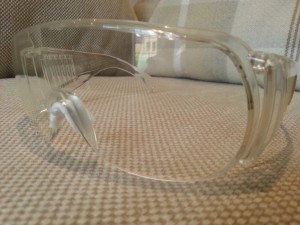
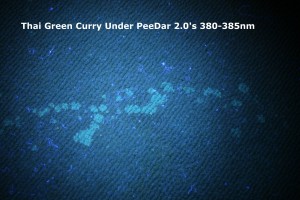
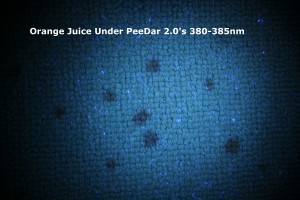
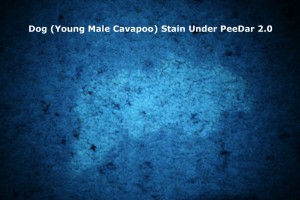


I purchased the PeeDar 365-370 LED flashlight and put it away,last year, and then found my toy poodle had soiled my rug as not only could I smell it, when I pulled the rug back (it is an area rug), I found lots of staining on the pad. I had the rug professionally cleaned, but I found some new spots on the pad recently as again smelled an odor. I recalled getting the PeeDar, put it new batteries, tested it on white paper for the blue glow, but despite using it the dark with curtains closed, cannot find the stains on the rug. It is patterned rug with a white backround. I have even tried using my prescriptions sunglasses with no differnce.Any suggestions as I know the urine is there?
Hi Melissa,
Many thanks for your message there, it does sound like you have a few obvious and smelly patches that should be lighting up nicely, let’s see if we can help you here! As a matter of thoroughness could you let me know if you’ve read all of the article you placed your comment on, and firstly, ensured that the urine was dried? Unfortunately the best way to do this is by getting a dry white piece of tissue paper and dabbing it a few times, in a very slow and deliberate manner, with some downward force, on the various perceived soiled areas, especially what you regard as the centre of the urine spot. If moist urine is present is should stick to the dry tissue, even the presence of very small visible droplets of moisture are a sign that more drying could be a good idea. Sometimes it may take a few days to dry the urine patches off (without your pet topping them up a few times each day) by closing off the area to all animals and any cleaning/moisture-introducing attempts.
Your dog’s faeces won’t glow, and may cover some of the glows, in addition the patterns on your carpet may break up the contrasting edges of any glows. The white background of the carpet should glow very strongly generally, this usually means stains on it will be much stronger too, although there can be the rare case of a more unusual material simply not glowing much.
Prescription sunglasses won’t help regards finding stains at all unfortunately, they will only act to make spotting anything more difficult. The PeeDar’s super low UV range doesn’t require any visual aids, such as amber coloured UV safety spectacles, to improve spotting stains, glows are more varied in colour and stronger without.
I’m pretty sure you’ll want to get rid of the stains quickly, when you’re having trouble seeing glows under UV moisture meters (these detect both dried and wet urine) along with your natural senses are best for locating stains to cleaned with the appropriate quality enzymatic pet mess cleaning solution. Fluorescein, a harmless dye swallowed by your pet and peed out over a few days, glows extremely strong under UV even when wet, ideal for when moisture may be affecting fluorescence, or pet urine is simply not that glowable. Ask your vet about this dye, he may be able to provide it.
Please let us know if you’ve tried the above advice, we can then move to the next stage if required.
Best regards
Steve Grzywacz
[Co-Founder – Urine Eradication Systems]
Thanks for so much valuable information . I’ll try to help with the basement
Urine has very little fluorescence, unless there are specific metabolic problems that the animal has. Especially if the pet has plenty of drinking water available. if a puppy has repeatedly urinated in a spot, enough for the carpet to smell, there is probably a population of bacteria in the carpet pile that are metabolizing the organic chemicals in the urine that causes the stale urine smell. Cleansers for pet stains often contain enzymes or other chemicals that will oxidize and deodorise those chemicals that may also fluoresce. It is very difficult to remove all contaminants from carpets – even professional carpet cleaners depend on chemical means to deodorise and de-contaminate carpets, as well as heat and water extraction..
This was the most informative … um, tinkle teaching site I’ve seen yet. I’ve spent hours. Also, kudos on being so wonderfully explanatory as well as informative! This is Uber confusing to me and I had a science degree. However I couldn’t defend an argument tonight that my parents were incorrect in their belief that a fluorescent light and a black light were the same thing, not to mention all the differences in how stains will show up. I learned so much, and feel a little more steeled in the next argument I’m sure to have with them regarding this! I’m joking (somewhat) – a dubious reason for learning such valuable information, but I truly will retain this for myself as well, since I see myself always having kitties (though, I hopefully won’t need to necessarily employ said knowledge). Either way, wonderfully written article for such a complex subject, and fantastic tips to boot. Well done! My grateful thanks.
Are there specific UV lights that detect pet fluids such as their urine or is it all UV lights that show bodily fluid? Also even after a carpet had been cleaned several time with a carpet cleaner could spots still appear under the UV lights?
Hi Katelyn,
Many thanks for your message. As far as we what we’ve seen, regards urine specifically, 380-385nm appears best for highlighting dried cat and dog urine. This seems largely due to certain chemicals in urine reacting with the UV to give the greatest quantity of visible light, the sheer quantity of UV, and very low amount of visible light, produced by the LEDs. We haven’t tested UVB lights, but we’re pretty sure all standard UVA (315-400nm) lights should create useful glows on the majority of pet urine.
We can’t with as much certainty say how effective UV is on other types of pet fluids. Judging from how some deep red food fluids have appeared in the past, e.g. red wine, if on a lighter coloured background blood may appear as dark/black patches. Our customers say semen is highlighted, I’ve seen dog puke be a very faint light green/yellow, faeces doesn’t seem to glow at all.
We were going to release a powerful enzymatic cleaner of our own, but during testing of some brands they didn’t always remove glows from urine stains. I’ve heard that some enzymatic cleaners do completely remove all traces of pet urine, including the glows, this may be true, but we haven’t experienced that ourselves yet.
I hope this has been helpful, and if you have any other questions just fire away! Good luck with your stain hunting and removal.
Best regards
Steve Grzywacz
[Co-Founder – Urine Eradication Systems]
What do you suggest to do with dark carpet?? I have a UV light, but it’s not picking up the urine stains. Is there glasses or some kind of spray that will make it show better? Ive blacked out the room and it still doesn’t help. I currently do not have any kind of goggles/glasses
Hi Lucy,
Apologies for the lateness of my response! Some very dark carpets may be an issue if they’re able to absorb most, or all, of the glows that are created under your PeeDar’s UV light. We’ve seen extremely poor glows, in some cases zero glows, on 1cm pile dark red carpets. Black or dark brown have shown reduced glows in tests too. The darker the colour the more light will get absorbed.
As with any UV light, all you can do is try to see if it works, following the advice on best practice, in the article above. PeeDar UV is not aided by tinted safety spectacles, a clear colour is best for seeing all glows at their brightest, and in their individual colours. Unfortunately, there is no spray we’re aware of that increases urine glows under UV.
If UV doesn’t help much, you’ll have to rely on your other methods of detection, e.g. your natural senses, but also tools such as urine-specific moisture meters (these do actually detect dried urine too, since urine absorbs moisture from the air) or fluorescein (vet-issued dye put on pet food, peed out later which glows very strongly under UV, even when wet).
For situations where detection seems impossible, generally your only two options are to clean or replace your carpet. Even at this point, you should seek to use quality enzymatic urine/pet mess cleaning solutions on suspect areas. It goes without saying that this can be quite expensive. This is a last resort, and typically isn’t necessary!
I hope you’ve managed to sort out your detection and cleaning issues. Once again, we’re so sorry to only have replied now, somehow we’d missed your comment! If you have any questions in the future do contact us directly, we’re always on hand to try and help.
Best regards
Steve Grzywacz
[Co-Founder – Urine Eradication Systems]
My daughter just recently had her carpets checked for cat soiling….. when the man scanned the carpet he found 5-6 areas that glowed (I could barely see them) they were very small areas. I have never known her two cats to ever mark or have an accident. However, my daughter was on TPN at home for 4 months. Could drips or small spills caused the markings? Every bag did contain sodium phosphate and we remember making the comment that the TPN smelled like cat urine. Don’t want kitties blamed when it was not them.
Hi Robin,
Many thanks for your good question. We’ve never tested TPN bags to see if, and how much, they glow under UV, but there is a chance their contents could glow. Many different types of food and drink glow under UV. The fact that you’ve never noticed your cats having urinated inappropriately before, combined with the very weak and small sized glows of the suspect areas under UV makes me think the fluid from the TPN bags could’ve been the source. Cats that urinate inappropriately do so in a particular way (e.g. a spray on more vertical surfaces at cat height, or pool or slight tear shape on the ground), and usually in the same places (therefore the patches would typically be of a noticeable size/smell). Providing the glows you found were in areas that the TPN bags could’ve been used, TPN fluids could well have been the source. Scanning your whole home, not just the carpets, for stains would help you gain a better idea of where they came from. If similar stains, for example, were in hard to reach areas that only cats would potentially go to, you may have the answer you were looking for. Also, if the glows are not white, straw or whitish-light-green in colour, but instead a strong blue, for example, they are likely to be from a different source, in this case bleach from cleaning fluids. Becoming a bit of a detective is a necessity when determining the source of glows under UV, UV simply locates stains!
I hope we’ve helped you here, do let us know how you got on, and feel free to ask us more questions if you have them.
Best regards
PandoraStocks LTD Customer Support
Once you treat the urine stain adequately, will it cease to glow? I have no sense of smell to tell if an odor remains.
Hi Stephanie,
Many thanks for your question. Although stain detection is our business, we have learnt quite a bit about the even more complex area of cleaning up afterwards. If you’ve used a good quality enzymatic pet urine cleaning solution, such as Urine Off, Nok Out or Anti-Icky Poo, applying the solution as instructed and repeating, if necessary on stubborn/older stains, up to 3 or 4 times, all of the urine stain’s ingredients should be completely eliminated.
When applying enzymatic cleaner, make sure to drench the area affected. Also, it is always a good idea to mop up as much liquid urine before any cleaning, and as much of the cleaning fluid as possible after the required amount of time for the cleaner to do its job has elapsed.
Non-enzymatic cleaners/cleaning methods don’t adequately remove urine stains, typically at the very least the non-water soluble uric acid and salts will remain. When these components come into contact with moisture they form uric acid crystals, this process releases odours which, although sometimes too faint for owners to smell, will often be detectable by your pet, and so promote re-offending in the same area. Uric acid is said by some sources to have a half life (time it takes to reduce in quantity by one half) of 6 years if left alone, so it is very important to completely remove this particularly stubborn part of urine.
After adequate enzymatic cleaning there should be no glows present from the stain at all. To maximise glows after cleaning, make sure you’ve given the cleaned area plenty of time to fully dry before using your PeeDar in the dark! Since you can’t smell things that well try and get a friend or partner to see if there are any smells remaining, or recurring after a week or two. You can also see if your pet detects the area, they typically hang about and sniff the area a fair amount if there’s something interesting (it could just be that new, interesting smells are now there though!). This is slightly off-topic, but the use of ‘fluorescein’ can help if your cat is re-offending, this is a harmless chemical dye that is placed on pet food and ingested, peed out over a few days. This dye glows a brilliant brighter urine colour even when wet, and can show where your pet has been urinating. Lastly, the use of a moisture meter can help detect suspect wet patches on or near cleaned areas.
I hope you’ve found this advice helpful, and we wish you the best of luck with finding and eradicating all your hidden stains. As always, we’re on hand to try and help, so do let us know if you have more questions.
Best regards
Steve Grzywacz
Co-Founder – Urine Eradication Systems
when I shine the light on the carpet I see a lot of tiny glowing speckles is this urine or dust and how do I know the difference.this light is awesome
Hi Debra,
Many thanks for your question. From our experience you’re probably seeing dust – if the glows are white, there is no stench, and the speckles are literally tiny but can be found in most rooms of your house. Dust tends to be seen in the corners of rooms, and around the bases of where objects rest, where it naturally builds up more due to being harder to hoover/clean.
Urine tends to give off a strong ammonia smell over time, it’s unmistakable, even if the sport is small. Urine also typically doesn’t ever produce glows in speckles, this is due to it having once been a liquid, and dried in larger pools or at the very least, drops. There may be a situation of urine having dried and flaked over time, but I’m not aware this could cause loads of really tiny speckles. Urine tends to glow in roughly circular shapes or tear drop shapes on flooring, or with a spray outline on more vertical surfaces, and with a light straw colour, sometimes with a light green tint if the urinating animal was a cat.
If you’re seeing extremely strong white or blue glows, you could be dealing with cleaning fluids that have dried and flaked over time. Cleaning fluid is typically used in a few specific areas, and has often got glows that appear in the shape associated with the manner of cleaning, e.g. swipes and maybe the odd drip.
Dried and powdered foods may cause glows that are similar to dust, but these would tend to be only found around the kitchen and other places you tend to eat. Becoming a bit of a detective is vital when using UV as part of your stain hunting arsenal.
I hope we’ve managed to help you here. PeeDar’s are amazing tools, and can be used for more than just urine detection :]
I hope you continue to enjoy your UV endeavours, and as always, feel free to ask us any questions you have.
Best regards
Steve Grzywacz
Co-Founder – Urine Eradication Systems
Hello,
i had a tenant that let his dog complete its business in the basement for 3 years. Now, he is out and I am left with a mess. The floors had been painted years ago, however there is bare concrete in many areas. I first cleaned with TSP, then vinegar, then Clorox and Nature Miracle. Although diminished, there is still a lingering odor. I have had several fans on for 2 weeks straight. When I look at the floor with a black light, the bare concrete appears purple, I do see small florescent specs here and there. The black paint looks green. I am not wearing any glasses, should I be. What is the best clean-up and deodorizer?
Hi Tim,
Many thanks for your message. Unfortunately we’re not yet able to confidently state how to clean concrete floors, since our current product knowledge and experience is primarily in stain detection under UV. We have no actual experience yet with removing pet stains from concrete. With that in mind these webpages might still be useful though, I think the first is maybe the one that you’ve followed: https://allgaragefloors.com/remove-pet-urine-odors-from-concrete/ and http://www.gatefans.net/gforums/threads/magical-cat-urine-and-dog-urine-smell-eliminator-recipe.28209/ . We’ve simply found these sites and don’t have any affiliation with them, but they are something we’d consider in your situation, and so they may be useful.
The first webpage is about how to specifically clean concrete floors. The second page is potentially useful regards fully removing stains with a little known formula. If you want to know more about the author’s information, try contacting them directly.
If you can afford it, and are serious about thorough stain and odour removal, I’d recmommend using a local professional cleaning service that has good experience with pet stain removal. If you prefer the DIY approach, even if just to start with, please see my comments that follow.
Regards the procedure in the first URL I showed you, I think it was a mistake to use harsh chemicals before the enzymatic cleaner. Harsh chemicals denature (i.e. damage) the important proteins (i.e. enzymes) needed for them to work. It’s generally always best to use enzymatic cleaners before harsh chemicals. Brands such as Nature’s Miracle, Rocco & Roxie and Anti Icky Poo seem to be amongst the best. When using enzymatic cleaners, it’s first useful to clean the area thoroughly with cool to warm (hot water binds proteins in urine to surfaces, making them harder to remove) plain tap water. And remove any solid debris.
In your case, I’d seriously look at removing all the paint from the flooring before any cleaning, since paint can contain urine and its smells, and also sheild the very porous, and probably heavily bonded with urine, concrete below from all your cleaning efforts.
Also, if you don’t want to use a professional service and you know you want to seal the area after your best cleaning efforts (for total odour control), then it’s worth considering grinding or acid etching the floor after paint removal, but before any cleaning. This lets the subsequent cleaning have more effect, by opening up the surface better. Grinding and etching lets garage floor coating (applied after all cleaning attempts) attach properly, and locks in any remaining odours.
Lastly, you might find hydrogen peroxide (3% strength) very effective as a replacement to TSP or Clorox, it may actually have the ability to not only kill all bacteria, but also completely alter the remaining urine’s chemical structure so that smells and post-clean glows under UV are completely removed. As with all harsh chemcials, use them first on a small area to see if there is any unwanted damage, and wear the appropriate protection, e.g. rubber gloves and eye protection. We don’t recommend vinegar for removing pet stains and odours, it doesn’t mask remaining urine smells enough, and has an often unwanted smell, pets regularly start re-offending in areas that were soaked in vinegar.
Purple glows are not usually indicative of urine, they seem more likely to have come from some of the harsh chemicals you used. Urine tends to glow a light straw colour from dogs, faeces doesn’t glow at all, and vomit can be very dull light green at most. What colour are the tiny specs under your PeeDar’s UV, and are they only in certain areas? It sounds like your paint is reacting in a fluorescent way to the UV, this could be helpful with paint removal.
Glows under PeeDars show up best without any aids, no glasses are required, you’ll then be able to see all glows at their most vibrant and colourful. If you do wear glasses, it is for UV-protection, but the damage from UV lights such as ours is not yet fully understood, and minimal at most even under extremely long use/exposure. If you’re worried about UV damage, wear clear-coloured and quality UV glasses. Tints are only necessary for cheaper, higher nanometer UV lights, e.g. around 390-405nm, cutting out visible purple light that hides glows from stains. We have a post about UV protection and glow detection on our blog.
That is all the advice I can give at the moment. We are actually looking into creating a cleaning solution that is effective at removing pet stains, completely, from all common surfaces, and so that any subsequent black light tests are passed. I’ll update this reply, and maybe create a few blog posts on stain removal in the future if we discover anything new.
I hope you’ve found this information useful, and can get rid of all your stains and odours for good soon. Let us know if you have any more questions, or how you get on!
Best regards
Customer Service – Urine Eradication Systems (A PandoraStocks LTD Company)
“In the past, I have purchased 2-in-1 flashlights that provide both “normal” and UV light. Almost inevitably, the normal white light lasts forever, but the UV light (which is what I want for my dog’s urine accidents!) fails in under a year. In researching this, I read that the UV part of the flashlight should actually be at a wavelength of 265-270nm. But the vast majority of these products (whether 2-in-1 OR totally UV) seem to have a wavelength of around 395NM. Several reviewers on websites which sell these products have also noted the premature death of their UV lights – and they tie this demise to this improper wavelength factor. Would be greatly appreciative of any insight you can offer!”
As far as we know, wavelength does not determine the life expectancy of a UV-emitting LED. LEDs last far longer than flourescent UV tubes, which is the reason we have them in our UV torches.
We’ve focussed our products on their effectiveness at detecting hidden cat and dog urine stains in the home environment. Both our PeeDar and PeeDar 2.0’s strong points are their more unique namometer ranges, compared with the competition’s 390-395nm range. Our first model, the PeeDar, was best at discovering the widest range of hidden stains, owing to it’s lower than normal 360-365nm range producing very little visible light, and a wider range of glow colours and more substances that were flouresced. Our improved PeeDar 2.0 with 380-385nm has, from what we researched and tested, the best urine-specific detection ability of any nm range for the price range it is sold in.
Our LEDs should last at least the average length of time expected, but as with all electronic products, there can be some variability from unit to unit.
Thank you for the information!!! My last led blacklight died (battery leak), but it cast so much visible light, that it overpowered the UV wavelengths. I have 3 cats, and was looking for a replacement that worked good for cats. Your not about 380-385 versus 395nm was a key piece of knowledge I did not have before.
And while you plugged (or the authors did) PeeDar, it too came up in an amazon search (once I added “380”), and after reading the product details, it really did stand out over the others. Ordering one right now, and again thanks for the added knowledge and brand recommendation!!!!